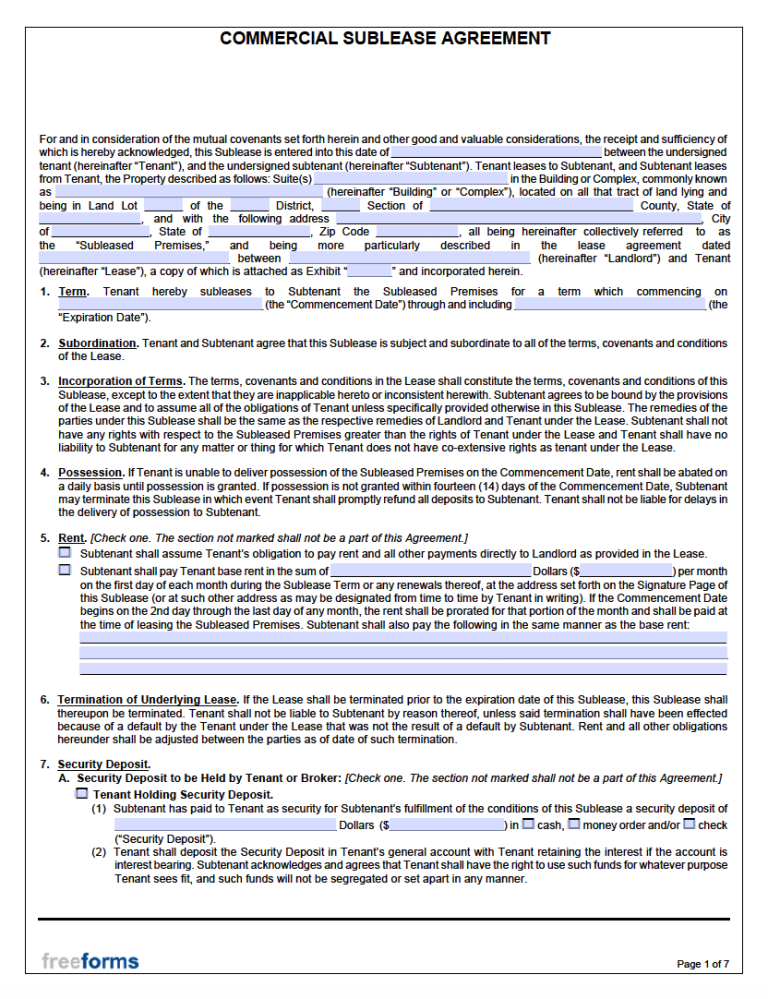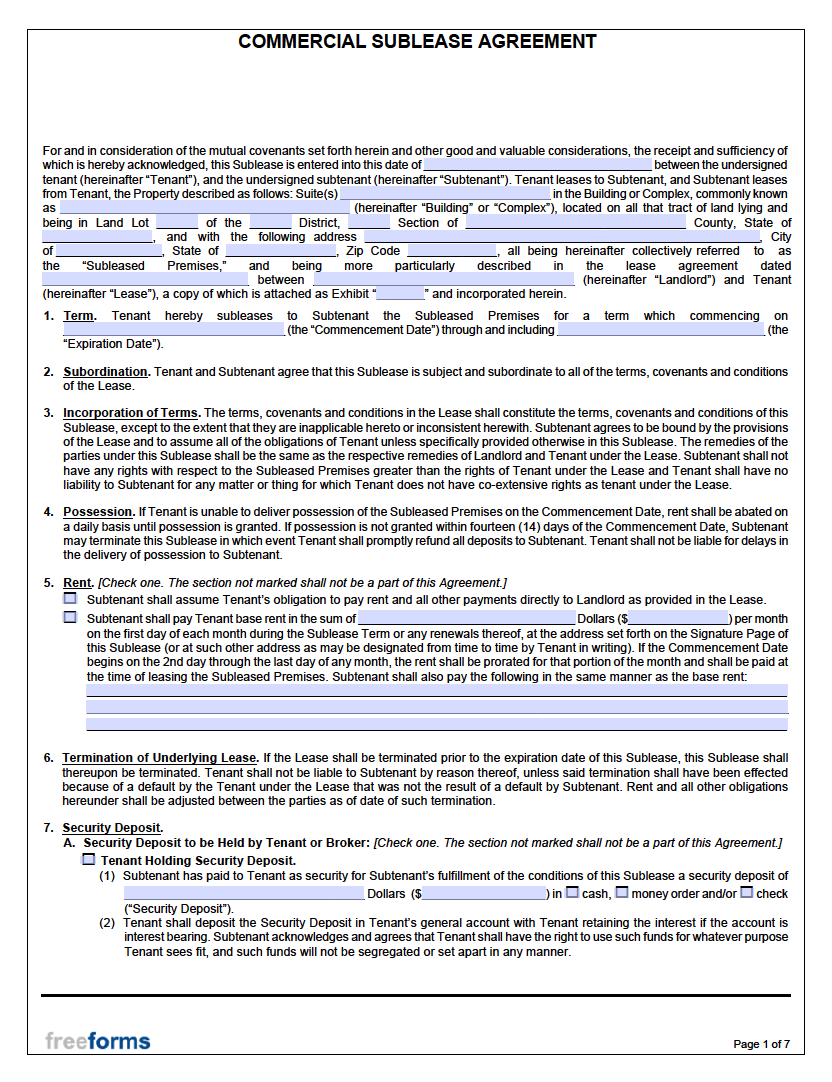Commercial Rental Application – It is vital that the sublessor thoroughly screen the prospective sublessee, as they are still responsible for the initial contract. In fact, the majority of the time, the original lessor will demand to be involved in the screening process in order to authorize the sublet.
What is a Commercial Sublease Agreement?
A sublease essentially confirms the terms of a guarantee for a renting tenant to grant use of designated commercial space to another leasing subtenant. When an individual/business entity is occupying a commercial property, they may have the desire to sublet the building (or their portion of the building) to a third-party company. Why would someone want to sublet their commercial property? Well, there are numerous reasons why someone would want to accomplish this, as commercial leases tend to have longer terms than residential. Some examples of why a company would need to utilize a sublease would be if they could no longer afford the payments, outgrew the property, need to relocate in general, etc.
To properly conduct this contract, it is important that the tenant checks their original lease to see if it allows for subleasing. If there is no mention, they should approach the landlord and try to acquire written consent. Once obtained, they can find a suitable subtenant and write out the terms of the sublet within the form, then follow it up with each party’s endorsements.
How to Sublease
Step 1 – Review the Original Lease Terms
In planning out the available options, it is critical first to examine the master lease in its entirety to determine the granted rights established in the document. Before proceeding with preparations to sublease a commercial space, it is necessary to ensure that the original lease permits the concession. In some states, leasing documents that do not specify a clause that covers the subletting of the property require that express permission is mandated before moving forward. Take note of declared provisions that refer to any associated recapture rights to avoid any arising issues. A recognized term in the language of the lease could allow the landlord to recapture possession of the property should a tenant request a sublease. Another aspect to investigate within the master leasing materials is whether the tenant has the right to retain a profit should the sublease gain an income higher than the lease amount in the original lease. Comprehensively deciphering each aspect of the contract will help you gain an understanding of how to proceed with the sublease.
Step 2 – Advertise the Sublease
After it has been confirmed that the leased space is eligible to be subleased, it is fundamental then to market the unit in search of a suitable subtenant. The initial consideration to take into account is whether it will be beneficial to your need to commission a broker. The assistance of a broker can help in several areas in the process of seeking a subtenant, negotiation, contract development, closing, and other time-consuming aspects of the matter. Contemplate whether the advantages gained with hiring a broker is worth it for the commission that will be required for their service. Researching an ideal agent for the job can be conducted at one of the listed sites below:
For those deciding to take the duty of subleasing into their own hands, the first action to take would be to assess the space you would like to sublease. Create a report to publicize classifying the following items:
- Square Footage of the Subleased Unit
- Desired Lease Term
- Sublease Rental Rate
- Building Class
- Condition and Layout of the Space
- General Description of the Shared Space
- Property Use Information
When figuring a rental rate, assemble a catalog of comparable properties on the market, as well as those that have been recently subleased. You can use the information to back the listed price when it comes time to negotiate. After obtaining the data, you can distribute the advertisement in a number of ways. Inquire with nearby small businesses to see if there is interest in relocating to a neighboring unit. In an effort to cast a wider net, you can take advantage of many sites geared toward leasing and subleasing. The following websites can assist in your search for subtenants where you can post your listing to reach a broader audience:
Once interested parties have made contact, it is essential to arrange to show the subject property to entice the prospect to enter into an agreement. Whether you elect to handle this process yourself or through a broker, it is vital to walk through the property to answer questions and persuade the potential subtenant to do business.
Step 3 – Screen Prospective Tenants
The next stage of subleasing is to examine the qualifications of the tenant before moving forward with a contractual obligation. Performing an extensive background investigation helps to protect the tenant, subtenant, and landlord to the unit to ensure that all are on the same page with the corresponding financials. Procuring a Commercial Rental Application for the prospective subtenant will grant access to the information associated with the individual and business to have an understanding of the rental, income, and credit standing. With the provided information, a background check can be conducted. Some qualifying rental screening services are supplied below:
It is crucial that the subtenant has the ability to afford the monthly payments. Tax returns may additionally be collected to demonstrate the capacity to produce enough income to compensate for the proposed arrangement. The factoring-in of the credit score of the individual will also give the parties the security that the applicant has a history of making payments to creditors and on time. After running the background examination and receiving approval, the parties can begin to deal with the specifics of the leasing transaction.
Step 4 – Negotiate the Terms of the Sublease
When structuring the lease, begin with a discussion with all involved individuals to determine the needs of all concerned with the dealing. From there, the sublease document can be utilized to develop a cohesive accord. It can be helpful to have a printed copy of the sublease on hand to go through each clause individually to properly create an understanding of what will work for all the participating parties. Instituting language to determine whether the subtenant makes payments directly to the landlord or utilizes the tenant as a go-between is indispensable. Some contracts may refer to a “Right to Cure” clause, permitting the tenant to compensate the landlord directly should the subtenant become unable to do so. Once hammered out, adjustments to the documentation can be revised to reflect the negotiated provisions.
Step 5 – Finalize the Transaction
The concluding point in the subleasing process is to complete the accord with the acceptance form all parties. By endorsing the proposed register containing the contractual terms and obligations, the commitment is validated in the eyes of the law. After signing, all required initial payments must be remitted, and the subtenant can then take possession of the commercial unit. All keys to the premises and private spaces, closets, and mailboxes are to be handed over to the new sublessee.

